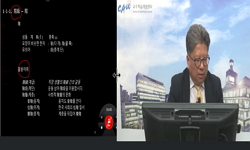본고는 韓國語를 專攻으로 운영하는 海外의 大學 중 이탈리아대학에서 이루어 지는 漢字授業을 위한 漢字敎材의 內容과 構成에 대해 具體的으로 논의한 것이 다. 본고의 논의는 세 가지 部...
http://chineseinput.net/에서 pinyin(병음)방식으로 중국어를 변환할 수 있습니다.
변환된 중국어를 복사하여 사용하시면 됩니다.
- 中文 을 입력하시려면 zhongwen을 입력하시고 space를누르시면됩니다.
- 北京 을 입력하시려면 beijing을 입력하시고 space를 누르시면 됩니다.

해외(海外) 대학(大學)의 한국어(韓國語) 학습자(學習者)를 위한 한자교재(漢字敎材)의 내용(內容)과 구성(構成) -이탈리아대학(大學)의 한국어(韓國語) 학습자(學習者)를 대상(對象)으로- = Chinese character textbook for foreign university students: systematic approaches to its contents and structure designed for the use of Korean language students in Italy
한글로보기https://www.riss.kr/link?id=A100045335
-
저자
김훈태 ( Hun Tae Kim ) ; ( Andrea De Benedittis ) (베니스대학)
- 발행기관
- 학술지명
- 권호사항
-
발행연도
2014
-
작성언어
Korean
-
주제어
한국어학습자 ; 한자교육 ; 한자교재 ; 한자 ; 한자어 ; 이탈리아대학 ; Foreign Learners of Korean Language ; Teaching of Chinese Characters ; Chinese Characters ; Sino-Korean Words ; University in Italy ; 韓國語學習者 ; 漢字敎育 ; 漢字敎材 ; 漢字 ; 漢字詞 ; 意大利大學
-
KDC
374
-
등재정보
KCI등재
-
자료형태
학술저널
- 발행기관 URL
-
수록면
337-369(33쪽)
- 제공처
-
0
상세조회 -
0
다운로드
부가정보
국문 초록 (Abstract)
본고는 韓國語를 專攻으로 운영하는 海外의 大學 중 이탈리아대학에서 이루어 지는 漢字授業을 위한 漢字敎材의 內容과 構成에 대해 具體的으로 논의한 것이 다. 본고의 논의는 세 가지 部分으로 이루어졌다. 첫 번째는 序文에 해당되는 부분으로 한국어와 관련된 한자의 내용이 다루어졌 다. 구체적으로, 韓半島에서의 漢字表記의 歷史, 漢字가 韓國語에 미친 影響 및 韓國語 內에서의 漢字의 位置 및 使用樣相 등을 論議하였다. 이 부분은 특히 非 漢字文化圈 한국어 학습자에게는 필요한 교육 내용이라고 할 수 있다. 두 번째는 교육 대상이 될 한자와 한자어의 선정과 관련된 부분이다. 이를 위해 현재 해외의 대학에서 사용되고 있는 몇몇 韓國語敎材에 제시되어 있는 語彙 중 한자 및 한자어들을 대상으로 하여 네 가지 選定基準(造語力·頻度數·難易度· 基礎字)에 따라 한자교재에서 다룰 한자를 選別하였다. 대상이 된 한자들은 다시 系列關係를 이루는 것이나 體系的으로 분류할 수 있는 것으로 묶어서 領域別로 제시되었다. 본고에서는 총 390여개의 한자와 이들 한자가 결합되어 사용되는 한자어 중에서 敎材, 日常生活, 時事的인 分野에서 자주 등장하는 것들을 選別하여 총 1110여개의 한자어를 제시하였다. 세 번째는 교재의 內容과 構成에 대한 부분이다. 이는 細部的으로 本文의 내용 과 구성, 읽기의 내용과 구성, 연습의 내용과 구성으로 나누어져 구체적인 예를 통해 살펴보았다.
다국어 초록 (Multilingual Abstract)
In this article we aim to analyze the contents and structure of ‘Chinese Characters within the Korean Language’, a textbook written for university-level education in Chinese characters. This article can be divided into three main parts. First and ...
In this article we aim to analyze the contents and structure of ‘Chinese Characters within the Korean Language’, a textbook written for university-level education in Chinese characters. This article can be divided into three main parts. First and foremost, let us examine the opening section of the manual; it introduces the learner into some important elements relative to Chinese characters, such as their history and usage in Korea, as well as their influence on the formation of the Korean vocabulary. This part is extremely important for learners whose mother tongue is neither Chinese nor Japanese. The second part deals with the methodology adopted for the selection of those characters and Sino-Korean words which are typically taught at the basic level. A preliminary analysis of Chinese characters and Sino-Korean words was carried out through several Korean manuals currently used at a number of foreign universities. Subsequently, four main criterions were adopted for further selection, thus sorting out Sino-Korean morphemes based on their coinage, frequency, level of difficulty and fundamentality. In order to systematize the selected characters, they were grouped in thematic units; a total of 390 characters are presented in the book. In the choice of derivative words, those largely used in textbooks, in daily life and in some specific fields were given priority, adding up to 1110 Sino-Korean words altogether. The third and last part of the textbook describes the general contents and structure of the textbook; it includes some examples to show in detail the various features of the units, readings and exercises.
동일학술지(권/호) 다른 논문
-
- 한국한자한문교육학회
- ( Hok Chung Ng )
- 2014
- KCI등재
-
- 한국한자한문교육학회
- ( Lin Han )
- 2014
- KCI등재
-
- 한국한자한문교육학회
- ( Deng Gang Lian )
- 2014
- KCI등재
-
中山國文字□,□,□舊釋釐正 -兼論秦文字之"使",楚文字之"事"
- 한국한자한문교육학회
- ( Ying Jieb Chen )
- 2014
- KCI등재




 KCI
KCI KISS
KISS






